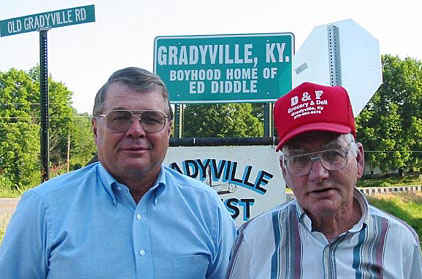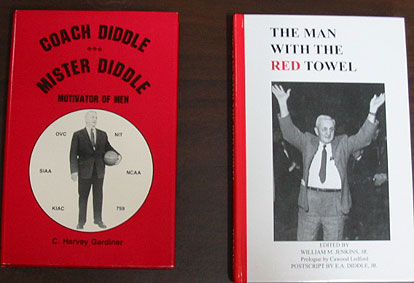| ||||||||||
Dr. Ronald P. Rogers CHIROPRACTOR Support for your body's natural healing capabilities 270-384-5554 Click here for details 


Columbia Gas Dept. GAS LEAK or GAS SMELL Contact Numbers 24 hrs/ 365 days 270-384-2006 or 9-1-1 Call before you dig Visit ColumbiaMagazine's Directory of Churches Addresses, times, phone numbers and more for churches in Adair County Find Great Stuff in ColumbiaMagazine's Classified Ads Antiques, Help Wanted, Autos, Real Estate, Legal Notices, More... 

|
Memories of Gradyville's Ed Diddle When he stepped down as coach of the Western Kentucky Hilltoppers in 1964, Gradyville native Ed Diddle had won more NCAA games than any other coach, according a biography of the famous Adair Countian on Western Kentucky University's web site, in an article entitled "If there is a basketball court in Heaven, Edgar Allen Diddle will be coaching the angels." Mr. Diddle helped Adair Countians From his earliest days, Ed Diddle loved sports When he was in high school, Diddle's family moved to Logan County, but he stayed behind, so he could finish high school with his Columbia teammates. Bo McMillen recruited Diddle to play basketball and football at Centre College, Richards remembers. "He played in the first football game he ever saw. He was so strong that he was an outstanding football player as well as starring in basketball and baseball for Centre. After he became established at Western, he loved to go into the chemistry classes at the beginning of each semester and, as "guest lecturer," write his chemistry formula on the board, "C6H0" and ask the class what compound he had written. He would tell the students, "It's Centre, 6; Harvard, 0. And don't you ever forget it." Then he'd tell them the story of the famous Praying Colonels of Centre College. That was the October 29, 1921 match in which Danville, Kentucky's Centre defeated unbeaten and top-ranked Harvard. Mr. Diddle patrolled Western's campus like it was his home. His residence was on campus, located behind College Heights High School, and there was a rock about 2 feet cubed that he used for a seat. If a person cut across the grass, be that person a freshman, sophomore, junior or senior, he always called out, "Stay off the grass, Freshman." One day, Dean Dero Downing's daughter, Ann, cut across the lawn, and Coach Diddle yelled out, "Hey, Freshman, stay off the grass!" but she ducked her head and kept going. He repeated the warning two more times, but she kept going, with her head turned away so she wouldn't be recognized. Finally, Mr. Diddle said, "Hey, Dean's Daughter, stay off the grass." The Famous Red Towel Mr. Diddle was a bit overweight in those days. He wore a trademark navy blue suit which caused him to perspire a lot during the games. He had a manager soak a towel in ice water, and Mr. Diddle would use the towel to wipe the sweat away. In the excitement of a game, he threw the towel in the air, and the crowd loved it. Kelly Thompson saw the crowd's reaction and told Mr. Diddle that he needed to make it a part of his act. The next year, when time came to go to Madison Square Garden, Kelly Thompson suggested that they dye some of the team's white towels red. Mr. Diddle, a master showman, threw it into the air often. Once, it landed on his head and some ladies sitting behind him laughed hysterically. This pleased Mr. Diddle, and he practice throwing the towel in the air so that it would land on his head. "The New York crowd went wild. And the sportswriters loved him," Richard said. "Mr. Diddle was a country Casey Stengel. He could mangle the language with his own Diddlese, just as Casey Stengel could, but the writers saw more than that. They saw that, in the same way Casey Stengel could inspire baseball team, Mr. Diddle could ignite basketball players. And, they loved the fast-paced, high-scoring, fast-break basketball style Mr. Diddle pioneered. That made him a favorite of the press."
On one occasion, Mr. Diddle was outside when a car came through the lane by his house going too fast, and the tires squealing. Mr. Diddle heard him coming and stepped in front of the car and stopped it like he was a traffic cop. "Hey, Freshman, where are you from, driving like that?" The driver responded, in what Mr. Diddle thought was a smart aleck fashion, "Chicago." Mr. Diddle was having none of it, "Don't try to fool me, Freshman, I saw those Illinois plates!" But many consider that and the story about Mr. Diddle telling the players to "line up alphabetically according to size" to be ploys. Jim Richards says, "I never wanted to tell stories that would in any way seem to cast him in a country bumpkin light," because Richards believes that Diddle calculated every statement he made, and wanted his opponents to underestimate him, let their guard down, and unknowingly cede tactical advantages to the Western Coach. A part of Gradyville lives on in memory of Mr. Diddle at Western. The late Helen Claycomb gave Western a cutting from Coach Diddle's mother's rose garden in Gradyville. The cutting was used in Diddle Park, located where Mr. Diddle's house used to stand, and is known as the Molly Diddle Rose. Mayor Gist remembers meeting Diddle This story was posted on 2003-07-07 09:02:43
Printable: this page is now automatically formatted for printing.
Have comments or corrections for this story? Use our contact form and let us know. (AD) - Many Reunion organizing efforts are also advertised in our REUNIONS category in our CM Classifeds. These are posted at a very low cost. See RATES & TERMS
More articles from topic Local History:
Coach Diddle: A Pretty Good Piece of Driving Where Are They Now?: Darlow Rexroat Delilah Hasa Jane Keltner, wife of William Riley Coomer Genealogy Society Meeting May 5 Reader needs help with Bryant history C.B. and L.G. Wilson Farming In Adair Co., KY Cooking On A Wood Stove The Short Hunters 1945 Plant Beds Of The 1940's 1931 Chevy On Hwy. 768, ca 1948 View even more articles in topic Local History |


|
||||||||
|
| ||||||||||
|
Quick Links to Popular Features
Looking for a story or picture? Try our Photo Archive or our Stories Archive for all the information that's appeared on ColumbiaMagazine.com. | ||||||||||
|
Contact us: Columbia Magazine and columbiamagazine.com are published by Linda Waggener and Pen Waggener, PO Box 906, Columbia, KY 42728. Please use our contact page, or send questions about technical issues with this site to webmaster@columbiamagazine.com. All logos and trademarks used on this site are property of their respective owners. All comments remain the property and responsibility of their posters, all articles and photos remain the property of their creators, and all the rest is copyright 1995-Present by Columbia Magazine. Privacy policy: use of this site requires no sharing of information. Voluntarily shared information may be published and made available to the public on this site and/or stored electronically. Anonymous submissions will be subject to additional verification. Cookies are not required to use our site. However, if you have cookies enabled in your web browser, some of our advertisers may use cookies for interest-based advertising across multiple domains. For more information about third-party advertising, visit the NAI web privacy site.
| ||||||||||






















































